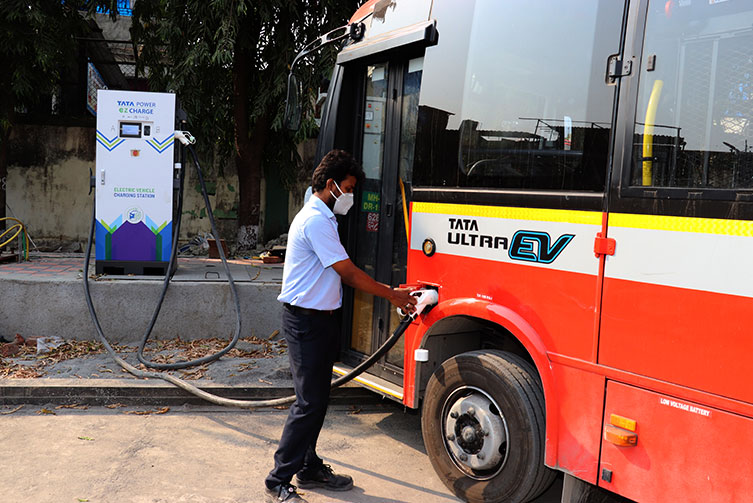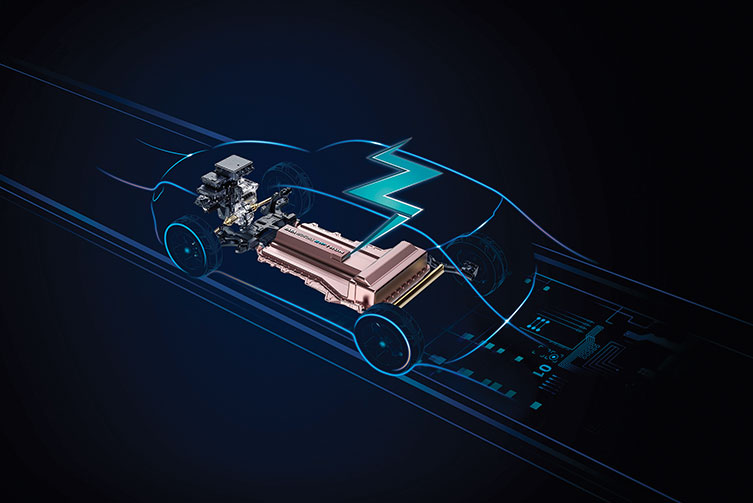December 2022 | 1767 words | 7-minute read
In January 2020, at a glittering event, Tata Motors launched India’s own electric SUV, Tata Nexon EV. The event was truly memorable, however, because it ushered in a new era of electric mobility in India with the announcement of the Tata UniEVerse.
“E-Mobility is an irreversible megatrend and an imperative for addressing pollution and generating job opportunities in India,” Tata Sons Chairman N Chandrasekaran said at the launch. “Through Tata UniEVerse, our group companies have synchronised their efforts to develop a holistic e-mobility ecosystem to accelerate the adoption of EVs (electric vehicles) in India.”
The collaboration appears to have achieved just that; merely two years later — and despite a global pandemic that slowed down economic activity around the world — Tata Motors celebrated the rollout of the 50,000th EV from its Pune plant in November 2022.
The heart of the uniEVerse
Tata Motors is at the centre of the EV ecosystem for the Tata group, working closely with group companies like Tata Power, Tata Chemicals, Tata Autocomp, Tata Consultancy Services (TCS), Tata Digital, Tata Elxsi and Tata Motors Finance.

When the automotive giant first set up the Electric Mobility Business in July 2018 to deliver on the company’s aspiration of providing innovative and competitive e-mobility solutions to the Indian market, EV adoption faced multiple barriers, including the high price of EVs (2x versus a conventional car), unavailability of charging infrastructure, range anxiety, lack of choices and risk-averseness to a new technology.
"E-Mobility is an irreversible megatrend and an imperative for addressing pollution and generating job opportunities in India." - Chairman N Chandrasekaran
“We developed a comprehensive approach to address these barriers,” says Shailesh Chandra, president, Passenger Vehicles (PV) Business Unit, Tata Motors. “We developed products with balanced range, performance and price, customised for specific use cases; piggybacked on existing ICE internal combustion engine) manufacturing facilities to gain benefits of scale; targeted identified customer groups and specific micro markets; and provided an ecosystem of solutions consisting of charging solutions, financing, etc, to targeted customers.”
Today, with a market share of 88 percent, it is clear that customer conversion has been successful in this short span of three years. “Customers are increasingly adopting EVs after learnings about their benefits, like instant acceleration, zero vibration, silent and superior drive experience and significantly lower ownership cost,” says Mr Chandra. “Approximately, 80 percent of Nexon EV buyers use the vehicle as their primary vehicle. Growing positive word of mouth is helping shift the customer base from early adopters to early majority.”
Driving net zero
At Tata Motors, sustainability is driven under the three pillars of Planet Resilience: Driving Net Zero, Pioneering Circular Economy and Preserving Nature and Biodiversity, in addition to its social and governance focus. Towards Driving Net Zero, Tata Motors is committed to achieving net-zero emissions by 2040 (PV business) and 2045 (Commercial Vehicles business) and has also committed to setting science-based targets.
“Our entire product strategy is now being driven by these ambitious goals,” says SJR Kutty, chief sustainability officer, Tata Motors. “We have already taken the lead in establishing ourselves in the PV market with an almost 90 percent electric cars market share. We are doing the same in the CV market, having established a Smart City Mobility Solutions business and bagging the lion’s share of electric bus orders from State Transport undertakings. For greening of the last mile, we recently launched the ACE EV that secured an order bank of 39,000 vehicles on the day of its launch. Also, Tata Motors has now positioned itself as a pioneer in the area of fuel cell buses with many buses already running on our roads in the pilot phase and having secured an order from IOCL for 15 such buses.”
Growing positive word of mouth is helping shift the customer base from early adopters to early majority: Shailesh Chandra, President, Passenger Vehicles
While the company has a very clear roadmap on the product side, it is even more aggressive in its operations, with its pledge to source 100 percent renewable electricity by 2030, which helps the company with significant reductions in its emissions, reduces expenses and makes the product greener overall.
Tata Motors has incorporated its sustainability agenda into its design and development as well, which help determine not just the choices the company makes upstream with its supply chain (for instance, a lower lifecycle emission material choice versus a higher one), but even actions that would be required in its operations (for example, a part that needs to be painted versus a part that comes as moulded in the final, desired colour). “This goes beyond operations and determines how well the product performs throughout its lifecycle, including how the parts are sourced through our supply chain in the upstream and how the product journeys through our sales and distribution channels in the downstream; how efficient, maintenance-free or easy to maintain it will be to ensure a longer life in its use-phase; and how easily it can be dismantled and recycled at its end of life,” explains Mr Kutty.
The company has employed digitisation to lower carbon footprint by running fewer prototypes for development. Through digital product development and production techniques, Tata Motors is also able to ensure that they achieve far greater optimisation of vehicle parameters, like meeting performance as well as high efficiency, and meeting safety as well as low weight.
Tata Motors is also working across various powertrain options to deliver zero emissions solutions across its vast product portfolio. This includes battery electric technology, hydrogen fuel cell technology, and the H2 IC Engine. The automaker is additionally working on low carbon materials, elimination of paints from certain parts and using industrial IoT to improve efficiency of operations.

The company’s zero emissions commitment extends to Scope 3 emissions as well, which includes emissions associated with the electric grid or ‘use phase’ emissions. “An EV emits about 40 percent less CO2e (when charged through the electric grid) than an equivalent fossil fuel-powered car,” says Mr Kutty. “And when our customers charge their EVs through rooftop solar sourced electricity (many of them already do) they are effectively producing zero emissions throughout their use phase.”
Building a charging ecosystem
Tata Power is also playing a critical role in the Tata uniEVerse, powering green mobility in India through a vast network of EV chargers.
Since the company set up its first EV charging station in 2017 in Mumbai — with an aim to build a network that made it easy for people to adopt EVs as part of it commitment towards sustainability — it has created a network of 3,000+ public and semi-public EV chargers, including 450+ public EV charging points across 350 national highways, with another 900+ chargers in various stages of installation. It has also set up 23,500+ home chargers (for private use) and 240+ bus charging points across India. Today, Tata Power has an ambitious plan of setting up EV charging stations across the country, with a focus on destination charging, highway charging and home charging.

“Our EV chargers are installed at prominent workplaces, commercial complexes and public parking spaces like those near metro or railway stations, highway locations, and similar points,” says Virendra Goyal, head, business development, EV Charging, Tata Power. “Highways are an important focus area for us as availability of EV charging infra on intercity roads will reduce range anxiety and encourage travel by EVs.”
Tata Power has energised some key, high-traffic density highway city pairs, like Mumbai-Ahmedabad, Delhi-Chandigarh, Delhi-Jaipur, Bengaluru-Chennai and Hyderabad-Vijayawada, among others. This highway penetration is a key priority for the company and is being continuously developed. “Similarly, we have identified tourist destinations like Tirupati, Mussoorie, Mahabaleshwar, Coorg, Dwarka, and others, where city EV owners are likely to undertake driving excursions,” says Mr Goyal.

The company’s moves in the EV space are part of its transformation programme, Tata Power 2.0, which focuses on customer centricity, sustainability and digital, so as to become the 'utility of the future’. The company’s EV charging initiatives are in line with the Government of India’s National Electric Mobility Mission Plan (NEMMP), which aims to develop EV charging infrastructure using the latest technological platform along with easy access to charging points.
Speeding into the future
Tata Power is committed to creating a robust EV charging infrastructure as EV penetration in India grows to 30 percent for private cars, 70 percent for commercial vehicles, 40 percent for buses and 80 percent for two and three wheelers by 2030. “We are working with private organisations, PSUs and government departments to create charging infra in their respective premises,” says Mr Goyal. “Tata Power has recently collaborated with the Indian Army and created charging infrastructure in the Delhi Cantonment to encourage defence officials to adopt e-mobility.”
"Tata Power has recently collaborated with the Indian Army and created charging infrastructure in the Delhi Cantonment to encourage defence officials to adopt e-mobility." - Virendra Goyal, head, business development, EV Charging, Tata Power

Tata Motors has also adopted an agile and flexible product development approach to progressively position EVs from mere conversion products to dedicated ones. “The evolution of the platform strategy will be in sync with market readiness, ecosystem development and rising customer adoption,” says Mr Chandra. “By FY27, we will be launching 10 EVs, which will have a mix of Gen1, Gen2 and Gen3 products.”
As the market evolves and battery prices come down, Tata Motors will aim to provide more range at the same accessibility level. “Gen2 vehicles will be based on the platform which is modified to accommodate more battery capacity and increase range up to 500km,” says Mr Chandra. “In addition, Gen2 vehicles will look different vis-à-vis the ICE counterpart. Gen3 EVs will be based on a dedicated EV platform wherein we will be able to provide certified range of 550km+. In addition, Gen3 EVs will have completely new body styles. The recently unveiled ‘Avinya’, slated for launch in FY26, will be the first Gen3 EV.”
All the players
Along with Tata Motors and Tata Power, Tata UniEVerse brings to the table the skills inherent in multiple group companies.
- Tata Chemicals is involved in cell development and localised manufacturing, while acting as a technical partner for evaluating lithium-ion cell manufacturing. It is also operating a pilot plant for lithium-ion battery recycling.
- Tata AutoComp has completed localisation of EV powertrain components and operates a battery assembly plant for Nexon and Tiago. Currently, EVs take 15 to 20 percent of the company’s plant space, while next year, in terms of revenue, it is likely to be 30 percent of the total revenue of the company.
- TCS is acting as a partner for driving advanced research and product design, especially in connected car tech.
- Tata Digital is a partner for building an integrated digital platform across Tata companies to enable cross-selling of EVs.
- Tata Motors Finance is offering structured financing solutions for fleet buyers and dealers. It also has partnerships with leading Indian banks.
- Anuradha Anupkumar



